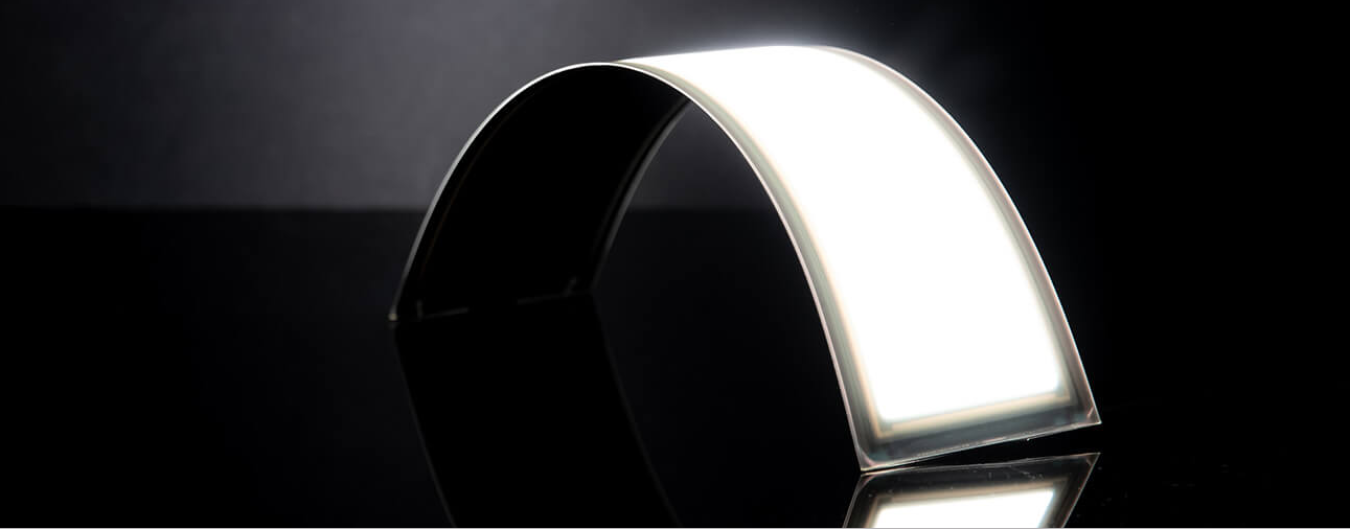American small businesses received a near-$44 million boost from EERE's SBIR program.
July 31, 2019
A thin, curved, high-efficiency OLED light engine from OLEDWorks.
American small businesses received a near-$44 million boost from the U.S. Department of Energy's (DOE) Office of Energy Efficiency and Renewable Energy Small Business Innovation Research (SBIR) program. Five buildings-focused, Phase II Release 2 grants awarded approximately $5 million to five small businesses. The projects, which are making advancements in building envelopes, building energy modeling, and lighting, have already demonstrated a level of commercial feasibility for further innovations in the second phase of research. The five projects:
Innovations in Opaque Building Envelope Performance
- Lightweight and Thermally Insulating Nanowood – (InventWood LLC., College Park, Maryland)
InventWood LLC is using delignified wood to create a new, bio-derived cellulose thermal insulation material that could be used in window frames, exterior insulating cladding, or prefabricated panels for new building construction or retrofit applications. This lightweight insulation material appears scalable and cost-effective, and a potential advancement for the construction industry and the energy efficiency of America’s buildings.
Transparent Conductive Anodes for Solid-State Lighting
- Printed Anodes and Internal Light Extraction Layers on Flexible Glass to Create Cost-Effective High-Efficacy Bendable OLED Lighting Panels – (OLEDWorks LLC, Rochester, New York)
OLEDWorks LLC will further develop and commercialize a highly energy-efficient lighting product in the form of uniquely thin and beautiful curved sheets of light to accelerate organic light-emitting diode (OLED) market growth. If all Phase II goals are met, the size of the lighting market available to OLED luminaire manufacturers could increase significantly from the high-end niche market of today to mainstream commercial and consumer markets. - High Performance Substrate Embedded Microgrids for High-Efficiency, Flexible Organic Light-Emitting Diodes – (Electroninks Inc, Austin, Texas)
Electroninks Inc. is developing an alternative, transparent conductor for optical-electronic applications like touch sensors, displays, and OLEDs that significantly outperforms today’s indium, tin, and oxygen (ITO) conductors. By using a new metal patterning technique that prints high-performance metal grids directly into glass and plastic, these new lattice-shaped “microgrid” conductors could outperform the manufacturing cost and performance of ITO.
Building Energy Modeling
- Portfolio-Level Energy-Efficiency Simulation (PLES) – (Maalka, Brooklyn, New York)
Maalka is extending its customizable framework for energy-efficiency program development and management. The framework leverages the increasing availability of building energy data and DOE’s open-source data standards and platforms and energy analysis tools (EnergyPlus, OpenStudio). The project targets the large and growing energy-efficiency program market of cities, utilities, larger owners, and energy service customers with a focus on supporting a move from individual energy conservation measures to packages and deep retrofits. - CAD-Integrated Web-Based Performance Simulation – (Ladybug Tools LLC, Fairfax, Virginia)
Ladybug Tools LLC will use DOE’s open-source EnergyPlus and Radiance tools, as well as OpenStudio’s new elastic cloud capabilities, to deliver a greater range of analysis services (and subsequent revenue streams) for architects. Phase I of this project involved creating a working radiance-based daylighting simulation service; Phase II work will focus on energy simulation.
Small businesses play a major role in spurring innovation and creating jobs in the U.S. economy. DOE's SBIR and STTR programs were created to leverage small business investment to advance innovation at federal agencies. Information on the DOE SBIR and STTR programs is available on the Office of Science SBIR website.

